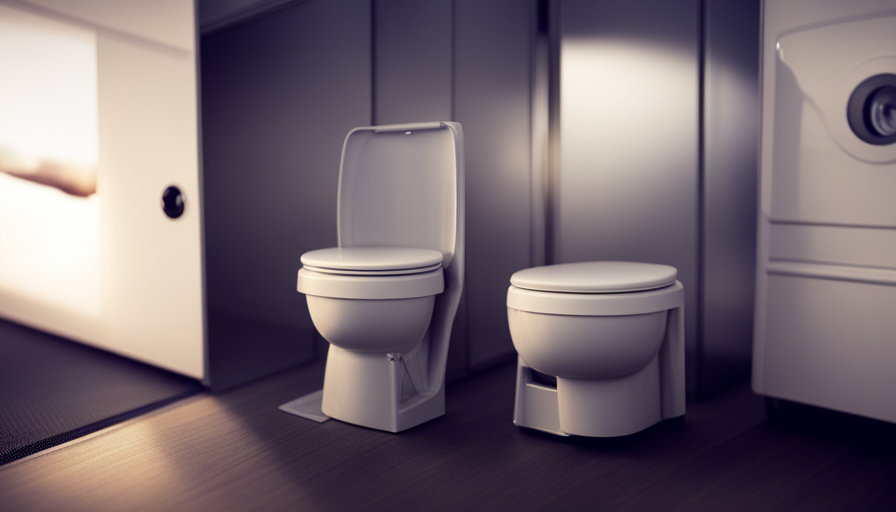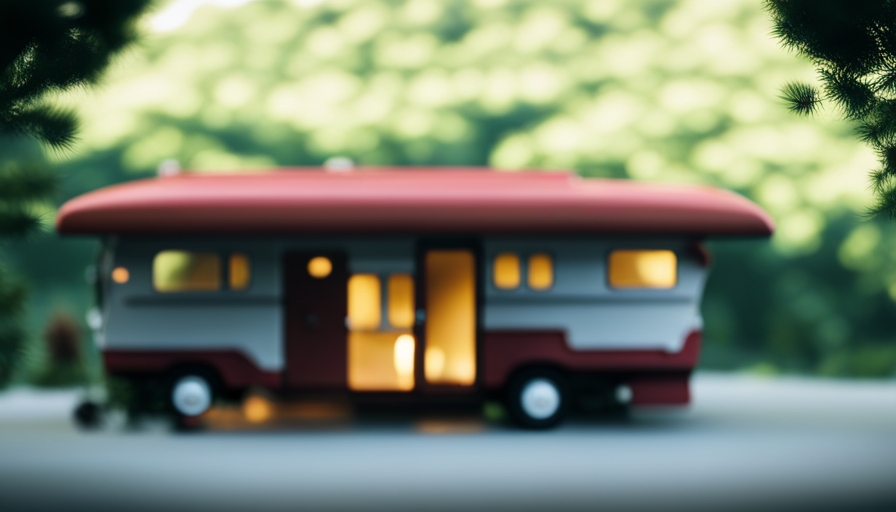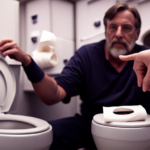Are you fed up with the inconvenience and cleanliness issues of standard flush toilets while camping? Prepare to experience a new journey with a dry toilet in your camper!
But what exactly is a dry toilet, you may wonder? Prepare to be amazed as we delve into the world of this innovative and environmentally-friendly toilet option.
Imagine a toilet that doesn’t require any water, yet still effectively manages waste and leaves no trace behind. Sounds like magic, right? Well, it’s not. A dry toilet is a revolutionary solution for campers who want to minimize their impact on the environment while enjoying the great outdoors.
In this article, we will explore the definition and purpose of a dry toilet, how it differs from traditional flush toilets, and the environmental benefits of using one in your camper. We will also dive into the mechanics of a dry toilet, the types available for campers, and address common concerns and myths surrounding their use.
So, buckle up and get ready to discover the convenience, flexibility, and eco-friendly nature of a dry toilet for your camping adventures. Let’s dive in!
Key Takeaways
- Dry toilets, also known as composting toilets, are waterless waste management systems for campers.
- They separate solids from liquids and use natural processes to turn waste into compost.
- They are environmentally friendly as they reduce water consumption and eliminate the need for chemical-based toilet cleaners.
- Dry toilets provide convenience, flexibility, and privacy for campers, eliminating the need for water or plumbing and can be set up anywhere in a camper.
The Definition and Purpose of a Dry Toilet
So, what exactly is a dry toilet in a camper? A dry toilet, also known as a composting toilet, is an innovative waste management system that doesn’t require water for flushing. Instead of flushing waste away with water, a dry toilet separates solids from liquids and uses natural processes to turn waste into compost. This compost can then be safely disposed of or used as fertilizer.
There are several advantages to using a dry toilet in a camper. Firstly, it’s a more environmentally friendly option as it reduces water consumption and eliminates the need for chemical-based toilet cleaners. This can have a significant impact on water conservation, especially in areas with limited water resources. Secondly, a dry toilet eliminates the need for sewer connections or dumping stations, making it a convenient choice for campers who want to travel off-grid or in remote areas. Lastly, the compost produced by a dry toilet is rich in nutrients and can be used to enrich soil, reducing the need for chemical fertilizers.
Now, let’s explore how a dry toilet differs from a traditional flush toilet.
How a Dry Toilet Differs from a Traditional Flush Toilet
Imagine stepping into a bathroom that doesn’t rely on water and flushing for waste disposal, but instead offers a unique and unconventional method of handling your bodily needs. This is exactly what a dry toilet in a camper provides.
So, how does a dry toilet differ from a traditional flush toilet? Well, the main difference lies in the way waste is managed. Instead of using water to flush waste away, a dry toilet uses a separate system to collect and contain it. This can be in the form of a composting or incinerating toilet.
One of the key benefits of a dry toilet is that it doesn’t require a water connection or plumbing infrastructure. This makes it an ideal solution for campers and RVs, where water supply may be limited or not readily available. Additionally, a dry toilet eliminates the need for chemical additives typically used in traditional toilets, reducing the environmental impact. It also produces compost that can be used as a fertilizer, promoting sustainability and reducing waste.
By utilizing a dry toilet in a camper, not only can you enjoy the convenience of a bathroom without the need for water and flushing, but you can also contribute to a more eco-friendly lifestyle.
With these environmental benefits in mind, let’s explore the advantages of using a dry toilet in a camper further in the next section.
The Environmental Benefits of Using a Dry Toilet in a Camper
Utilizing a composting or incinerating waste management system in a recreational vehicle offers numerous environmental advantages. One of the main benefits is the reduced environmental impact compared to traditional flush toilets. Dry toilets in campers don’t require any water for flushing, which means that no water is wasted in the process.
This is especially important when you consider that water is a precious resource, and conserving it is crucial for sustainable living.
Additionally, dry toilets in campers also help in minimizing pollution. Traditional flush toilets contribute to water pollution as the wastewater contains harmful chemicals and bacteria that can contaminate natural water sources. With a dry toilet, there is no wastewater generated, which means there is no risk of polluting the environment.
Another advantage of using a dry toilet is the cost savings. Traditional flush toilets require regular maintenance, including plumbing repairs and water bills. However, with a dry toilet, there’s no need for plumbing or water supply, resulting in significant cost savings over time.
Using a dry toilet in a camper not only has environmental benefits, such as reducing water consumption and minimizing pollution, but it also saves money.
Now that we understand the environmental advantages of a dry toilet, let’s delve into the mechanics of how it works.
The Mechanics of a Dry Toilet: How Does It Work?
When you step into the eco-friendly bathroom of your home on wheels, you’ll marvel at the ingenious mechanics that efficiently manage waste without a drop of water. A dry toilet in a camper is a simple yet effective system that relies on its mechanics to function properly.
The main components include a waste collection chamber, a ventilation system, and a separation mechanism.
The functionality of a dry toilet begins with the waste collection chamber, which is usually a sealed container located beneath the toilet seat. This chamber is designed to hold human waste until it can be properly disposed of.
Alongside the waste collection chamber, a ventilation system is in place to ensure proper airflow and prevent unpleasant odors from escaping. This system typically consists of a fan that creates negative pressure, drawing air from the toilet bowl and directing it outside the camper.
To separate liquid and solid waste, a mechanism such as a urine-diverting system or a separating funnel is employed. This ensures that the waste is efficiently managed and allows for easier disposal or composting.
The mechanics of a dry toilet in a camper are designed to efficiently manage waste without the use of water. These systems incorporate waste collection chambers, ventilation systems, and separation mechanisms to ensure proper functionality.
With this understanding of how a dry toilet works, let’s delve into the different types of dry toilets for campers: composting vs. incinerating.
Types of Dry Toilets for Campers: Composting vs. Incinerating
Step into the eco-friendly bathroom of your home on wheels and discover the two types of ingenious waste management systems: composting and incinerating. When it comes to dry toilets for campers, these two options offer different advantages and drawbacks.
Composting toilets are a popular choice among campers due to their many advantages. First, they’re environmentally friendly, as they turn waste into compost that can be safely disposed of or used as fertilizer. Second, they require little to no water, making them a sustainable option for water conservation. Lastly, they’re easy to install and maintain, with minimal odor when properly managed.
On the other hand, incinerating toilets have some drawbacks. Although they eliminate waste by burning it to ashes, they require a significant amount of energy to function. This can be a downside for campers who rely on alternative power sources. Additionally, the process of incineration can produce unpleasant odors and may require more frequent maintenance to dispose of the ashes properly.
Transitioning to the next section about maintenance and care tips for a dry toilet in a camper, it’s essential to ensure proper functioning and hygiene to maximize the benefits of your chosen waste management system.
Maintenance and Care Tips for a Dry Toilet in a Camper
Taking care of our eco-friendly waste management system in our home on wheels is crucial for optimal performance and cleanliness. Maintenance tips for a dry toilet in a camper are essential to ensure its smooth operation.
Regular cleaning is important, and we recommend using a mild, eco-friendly cleaner to avoid damaging the toilet. Start by emptying the waste container and rinsing it thoroughly with water. Scrub the toilet bowl and seat with a brush and cleaner, making sure to remove any residue. Don’t forget to clean the ventilation system and check for any clogs or blockages.
Additionally, it’s important to regularly inspect the toilet’s components and replace any worn-out parts. To prevent odors, consider using natural odor-absorbing products or installing an exhaust fan. Remember to follow the manufacturer’s instructions for maintenance and cleaning techniques specific to your dry toilet model.
By properly maintaining and cleaning your dry toilet, you can ensure its longevity and functionality. Speaking of concerns and myths about using a dry toilet, let’s address them in the next section.
Addressing Concerns and Myths about Using a Dry Toilet
Don’t flush away your worries – let’s debunk the concerns and myths surrounding the use of a nature-inspired waste management system. Addressing concerns and dispelling myths about using a dry toilet is crucial to understanding its benefits and promoting its usage.
One common concern is the odor issue. Some people believe that a dry toilet will emit unpleasant smells, but in reality, modern dry toilet systems are designed with effective ventilation systems that keep the air fresh and odor-free.
Another myth is that dry toilets are unsanitary. However, this is far from the truth. Dry toilets utilize a combination of natural processes, such as composting or dehydration, to break down the waste and turn it into a safe and hygienic material.
Additionally, there is a misconception that maintaining a dry toilet is difficult and time-consuming. On the contrary, these systems are designed to be low-maintenance, requiring minimal effort and attention. With regular emptying and proper care, a dry toilet can provide a hassle-free experience.
Transitioning into the subsequent section about the convenience and flexibility of a dry toilet for camping trips, let’s explore how this nature-inspired waste management system can enhance your outdoor adventures.
The Convenience and Flexibility of a Dry Toilet for Camping Trips
Imagine the freedom of being able to enjoy your camping trip without worrying about finding a restroom or dealing with the inconvenience of traditional waste management systems. With a dry toilet in your camper, this convenience becomes a reality.
A dry toilet is a portable, self-contained system that eliminates the need for water or plumbing. It is designed to be compact and lightweight, making it easy to carry and install in your camper.
The convenience of a dry toilet is unmatched. You can set it up anywhere in your camper, allowing you to camp in remote locations or areas without restroom facilities. It also eliminates the hassle of having to find and use public restrooms or shared facilities, providing you with more privacy and hygiene. Additionally, a dry toilet is easy to clean and maintain, requiring minimal effort and time.
The portability of a dry toilet is another great advantage. It can be easily transported from one location to another, ensuring that you have access to a restroom wherever you go. It is also suitable for various types of camping vehicles, including motorhomes, trailers, and vans.
Finding the right dry toilet for your camper is important. Factors to consider include size, capacity, and installation requirements.
Finding the Right Dry Toilet for Your Camper: Factors to Consider
Now that we understand the convenience and flexibility of a dry toilet for camping trips, let’s dive into the factors to consider when finding the right one for your camper.
There are several key elements to keep in mind when making this decision.
-
Space: Consider the dimensions of your camper and the available space for a dry toilet. Measure the area to ensure a proper fit.
-
Capacity: Determine the capacity you require based on the number of people using the camper. A larger capacity may be necessary for extended trips or larger groups.
-
Installation: Look for a dry toilet that’s easy to install and maintain. Consider whether you want a portable or fixed model, as this’ll impact installation options.
-
Pros and Cons: Evaluate the pros and cons of different types of dry toilets. Some may require more maintenance, while others may have specific waste disposal requirements.
Considering these factors will help you find the perfect dry toilet for your camper.
Next, we’ll explore testimonials and experiences from campers who’ve already embraced the use of dry toilets, providing valuable insights into their effectiveness and practicality.
Testimonials and Experiences from Campers Who Use Dry Toilets
Wow, campers are raving about the life-changing convenience and freedom that comes with using a dry toilet on their outdoor adventures! Testimonials from fellow campers highlight the many benefits of using a dry toilet in a camper.
One camper shared how having a dry toilet eliminated the need to constantly search for public restrooms while on the road. This allowed them to stay in remote areas and enjoy the beauty of nature without worrying about finding a bathroom.
Another camper mentioned how the dry toilet’s portability made it easy to set up and use in any location, whether it was in a campground or a secluded spot in the wilderness.
However, it’s important to note that there are also some drawbacks to using a dry toilet. Some campers mentioned that the maintenance and cleaning of the dry toilet can be a bit time-consuming, especially when it comes to disposing of waste. Additionally, the initial cost of purchasing a dry toilet may be higher compared to traditional RV toilets.
Despite these drawbacks, the convenience and freedom offered by a dry toilet seem to outweigh the negatives for many campers.
Campers have shared their positive experiences with using dry toilets in their campers. The testimonials highlight the benefits of convenience and freedom, while also acknowledging the drawbacks of maintenance and cost.
Overall, it seems that using a dry toilet in a camper is a game-changer for outdoor enthusiasts seeking a more self-sufficient and hassle-free camping experience.
Frequently Asked Questions
Are dry toilets in campers more expensive than traditional flush toilets?
When comparing the cost of dry toilets in campers to traditional flush toilets, there are a few factors to consider. Dry toilets tend to be more cost-effective in terms of maintenance and water usage. They don’t require plumbing or a water supply, which can save on installation costs.
Additionally, dry toilets have a lower environmental impact as they don’t consume water or contribute to sewage systems. Overall, dry toilets in campers are often a more affordable and eco-friendly option.
How often does a dry toilet in a camper need to be emptied?
A dry toilet in a camper typically needs to be emptied every few days, depending on usage. The frequency of emptying may vary based on the size of the toilet and the number of people using it.
However, the benefits of using a dry toilet in a camper are numerous. It eliminates the need for water, making it more environmentally friendly. Additionally, it requires less maintenance and reduces the risk of plumbing issues compared to traditional flush toilets.
Can a dry toilet in a camper be used during freezing temperatures?
Yes, a dry toilet in a camper can be used during freezing temperatures. For example, I’ve recently gone on a winter camping trip and used my dry toilet without any issues. Dry toilet maintenance in freezing temperatures is relatively simple. The main benefit of using a dry toilet in freezing temperatures is that there’s no water involved, so there’s no risk of freezing or bursting pipes. Additionally, there’s no need for chemical additives or antifreeze, making it an eco-friendly option.
Are there any restrictions on using a dry toilet in certain camping areas or parks?
There are indeed restrictions on using dry toilets in certain camping areas or parks, including national parks. These restrictions are put in place to protect the environment and ensure proper waste disposal.
However, using a dry toilet in a camper has many benefits. It’s a sustainable and eco-friendly option, as it doesn’t require water or chemicals. It also eliminates the need for traditional sewage systems, making it easier to camp in remote areas.
Can a dry toilet in a camper produce any unpleasant odors?
Oh boy, let me tell you about the wonderful world of dry toilets in campers! Now, I know what you’re thinking, ‘Do they produce any unpleasant odors?’ Well, I’m here to put your worries to rest.
While dry toilets in campers can sometimes emit unpleasant odors, fear not! With proper maintenance, these odors can be minimized. Regularly emptying the waste container, using odor-reducing products, and ensuring proper ventilation are essential maintenance tips to keep those smells at bay.
Now, let’s dive into what exactly a dry toilet in a camper is…
Conclusion
In conclusion, embracing the concept of a dry toilet in our camper was like discovering a hidden gem amidst a vast wilderness. Like a compass guiding us on our eco-friendly journey, it offered a sustainable solution that harmonized with nature.
Its innovative mechanics danced like a symphony, effortlessly transforming waste into valuable resources. We debunked the myths that whispered in the wind and found convenience and flexibility in this unconventional choice.
So, fellow campers, let’s embark on this adventure together, finding the perfect dry toilet that’ll elevate our camping experience to new heights.



















